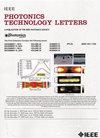利用液晶空间光调制的VCSEL阵列光束整形
IF 2.5
3区 工程技术
Q2 ENGINEERING, ELECTRICAL & ELECTRONIC
引用次数: 0
摘要
光束整形和均匀性是各种光学应用的关键要求,包括激光加工、美容治疗、医疗治疗、全息摄影和光通信。Gerchberg-Saxton (GS)算法和混合输入输出(HIO)算法被广泛用于波束整形;然而,它们有明显的局限性。虽然GS算法收敛速度快,但容易在局部极小值处停滞。相反,HIO算法改进了搜索,但由于参数设置固定,存在不稳定性。本研究提出了一种改进的相位检索算法,该算法综合了高斯算法和HIO算法的优点。它引入了一个自适应阻尼因子($\alpha $),该因子随着迭代的增加而增加,以增强均匀性,同时保持稳定性。此外,对$\beta $参数采用动态插值策略防止发散。数值模拟验证了该方法的优越性能,波束均匀度达到了88.62% and an energy efficiency of 72.63%, outperforming both the GS and HIO algorithms. This method effectively balances convergence speed, stability, and uniformity, offering a promising solution for high-precision beam shaping. In the experimental validation, the generated grayscale hologram is uploaded to the liquid crystal spatial light modulator (LCSLM), thereby facilitating the homogenization of the vertical-cavity surface-emitting laser (VCSEL) beam. This process yields a rectangular flat-top beam with a measured beam uniformity of 83.85%.本文章由计算机程序翻译,如有差异,请以英文原文为准。
Beam Shaping of VCSEL Arrays Utilizing Liquid Crystal Spatial Light Modulation
Beam shaping and uniformity are critical requirements in various optical applications, including laser processing, aesthetic treatments, medical therapies, holography, and optical communication. The Gerchberg-Saxton (GS) algorithm and the hybrid input-output (HIO) algorithm are widely used for beam shaping; however, they exhibit notable limitations. While the GS algorithm converges quickly, it is prone to stagnation at local minima. Conversely, the HIO algorithm improves exploration but suffers from instability due to fixed parameter settings. This study proposes an improved phase retrieval algorithm that integrates the strengths of both GS and HIO. It introduces an adaptive damping factor ( $\alpha $ ) that increases over iterations to enhance uniformity while maintaining stability. Additionally, a dynamic interpolation strategy is applied to the $\beta $ parameter to prevent divergence. Numerical simulations confirm the superior performance of the proposed method, achieving a beam uniformity of 88.62% and an energy efficiency of 72.63%, outperforming both the GS and HIO algorithms. This method effectively balances convergence speed, stability, and uniformity, offering a promising solution for high-precision beam shaping. In the experimental validation, the generated grayscale hologram is uploaded to the liquid crystal spatial light modulator (LCSLM), thereby facilitating the homogenization of the vertical-cavity surface-emitting laser (VCSEL) beam. This process yields a rectangular flat-top beam with a measured beam uniformity of 83.85%.
求助全文
通过发布文献求助,成功后即可免费获取论文全文。
去求助
来源期刊

IEEE Photonics Technology Letters
工程技术-工程:电子与电气
CiteScore
5.00
自引率
3.80%
发文量
404
审稿时长
2.0 months
期刊介绍:
IEEE Photonics Technology Letters addresses all aspects of the IEEE Photonics Society Constitutional Field of Interest with emphasis on photonic/lightwave components and applications, laser physics and systems and laser/electro-optics technology. Examples of subject areas for the above areas of concentration are integrated optic and optoelectronic devices, high-power laser arrays (e.g. diode, CO2), free electron lasers, solid, state lasers, laser materials'' interactions and femtosecond laser techniques. The letters journal publishes engineering, applied physics and physics oriented papers. Emphasis is on rapid publication of timely manuscripts. A goal is to provide a focal point of quality engineering-oriented papers in the electro-optics field not found in other rapid-publication journals.
 求助内容:
求助内容: 应助结果提醒方式:
应助结果提醒方式:


